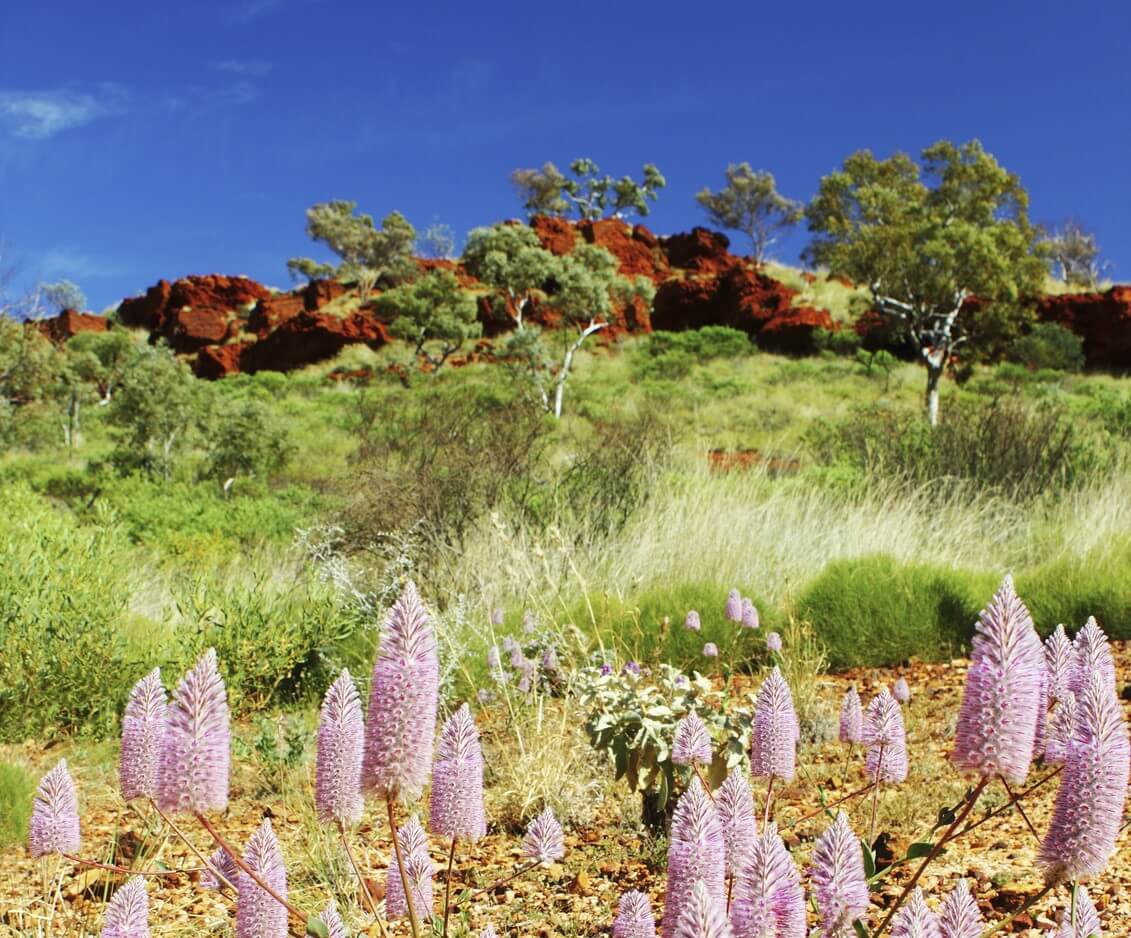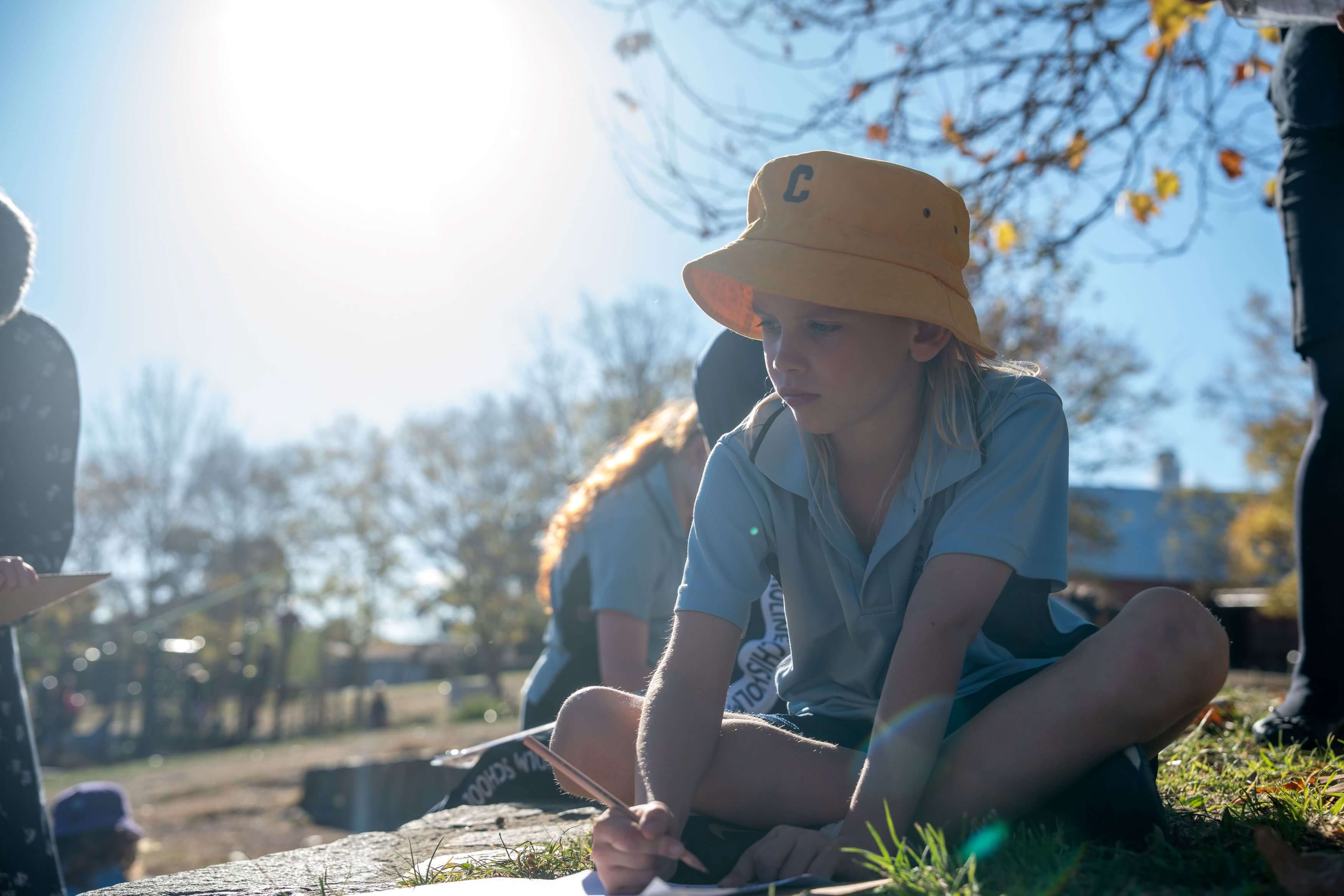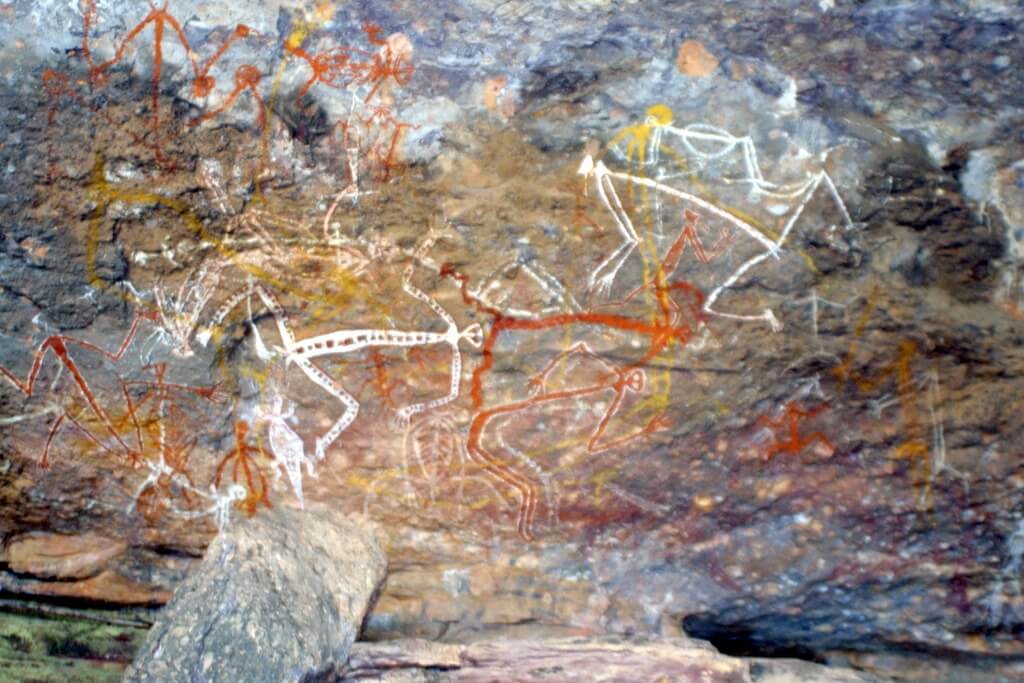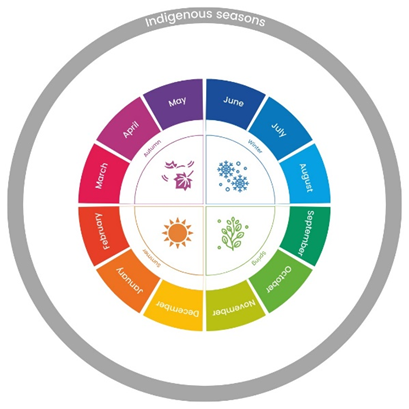Any day outdoors
View Sequence overviewStudents will:
- identify that changes in weather and seasons can be observed and described.
- describe seasonal patterns can be observed and described.
Students will represent their understanding as they:
- discuss ideas and experiences of change.
- identify how phenomena can change at different rates.
- use language to make distinctions, speculate and question.
In this lesson, assessment is summative.
Take note of:
- Are students able to order images of changes across a time scale?
- Are students able to identify the conditions that signify a change in seasons?
- Are students able to recognise the extensive knowledges of daily and seasonal changes in weather patterns and landscape held by First Nations Australians?
Refer to the Australian Curriculum content links on the Our design decisions tab for further information.
Whole class
Class science journal (digital or hard-copy)
Weather watch class table
Enlarged demonstration copy of Natural changes Resource sheet cards, individually cut out
Natural changes Resource sheet cards, individually cut out
Three signs showing the words 'Yes', 'No' and 'I don't know'
Enlarged demonstration copy of Calendar Wheel Resource sheet
Optional: two photographs of different features around the school at the potential locations for the picnic that you think will have seasonal change.
Time-lapse videos of natural and constructed changes. These could include:
- the sky changing from night to day, e.g. March 12 Farm Sunset Timelapse.
- a construction site, e.g. Construction Time-Lapse: Single Family Home Built in 5 Months.
- tree changing with the seasons, e.g. One year in 2 minutes.
- ants building a nest, e.g. Busy Ants Timelapse.
- a spider building a web, e.g. Spider Net Building Timelapse.
- a flower unfurling, e.g. Time lapse Dandelion flower to seed head.
How do you know when rain is coming? video by the ABC
Each student
Individual science journal (digital or hard-copy)
Calendar wheel Resource sheet
Lesson
The Inquire phase allows students to cycle progressively and with increasing complexity through the key science ideas related to the core concepts. Each Inquire cycle is divided into three teaching and learning routines that allow students to systematically build their knowledge and skills in science and incorporate this into their current understanding of the world.
When designing a teaching sequence, it is important to consider the knowledge and skills that students will need in the final Act phase. Consider what the students already know and identify the steps that need to be taken to reach the level required. How could you facilitate students’ understanding at each step? What investigations could be designed to build the skills at each step?
Read more about using the LIA FrameworkRe-orient
Review the weather watch table and add today's entry. Discuss what the class has observed and recorded about the weather in the context of what they have learned so far about clouds, rain, temperature and wind.
Discuss how the weather has changed over the days/weeks of the weather watch journal.
The Inquire phase allows students to cycle progressively and with increasing complexity through the key science ideas related to the core concepts. Each Inquire cycle is divided into three teaching and learning routines that allow students to systematically build their knowledge and skills in science and incorporate this into their current understanding of the world.
When designing a teaching sequence, it is important to consider the knowledge and skills that students will need in the final Act phase. Consider what the students already know and identify the steps that need to be taken to reach the level required. How could you facilitate students’ understanding at each step? What investigations could be designed to build the skills at each step?
Read more about using the LIA FrameworkIdentifying and constructing questions is the creative driver of the inquiry process. It allows students to explore what they know and how they know it. During the Inquire phase of the LIA Framework, the Question routine allows for past activities to be reviewed and to set the scene for the investigation that students will undertake. The use of effective questioning techniques can influence students’ view and interpretation of upcoming content, open them to exploration and link to their current interests and science capital.
When designing a teaching sequence, it is important to spend some time considering the mindset of students at the start of each Inquire phase. What do you want students to be thinking about, what do they already know and what is the best way for them to approach the task? What might tap into their curiosity?
Read more about using the LIA FrameworkIs the weather the same all year round?
Pose the question: Is the weather always the same at Christmas, your birthday, Easter, every holiday?
Discuss, adapting to suit the context and experience of your students. The goal is to encourage students to realise the commonalities and differences in weather at certain times of the year.
- Is it always hot/wet at Christmas?
- Do you go swimming in the summer/New Year holidays? Why do you go swimming at that time of the year?
- What did you do in the June/July school holidays?
- Did you do the same thin in the Christmas holidays? Why or why not?
- What was the weather like at 'Jack's' birthday party this year? What clothes did you wear to the party in January/June?
- What was the weather like at 'Jill's' party?
- How does the weather change at different times of the year?
Show students the time-lapse videos of different changes and discuss.
- What did you see happening?
- What changed? Why did the changes happen?
- How do you think the videos were made?
Optional: Introduce the photographs of different features around the school or for the potential location of the picnic. Ask students where they think the photographs were taken.
Ask students to suggest if they think anything will change between now and the time of the picnic.
Record students’ thoughts in the class science journal.
Seasons
Seasons can vary and are largely influenced by the tilt of the Earth's axis and our position on Earth.

Natural changes occur over different durations and frequencies. Observations of these changes over time often reveal patterns and help us determine their root cause.
Seasons can vary and are largely influenced by the tilt of the Earth's axis and our position on Earth, which have an effect on the angle of the Sun's rays as the Earth revolves around it.
Different places and cultures in Australia observe different seasons. Being such a large country, with locations close to the equator in the north and closer to Antarctica in the south, many locations in Australia experience the seasons differently. Some people in northern tropical areas of Australia identify two seasons: the wet and the dry. Others, such as the Nunggubuyu people, identify five seasons. In the south of Australia people commonly identify four seasons, each lasting approximately three months: spring, summer, autumn and winter.
We often identify seasonal changes as characteristics of the landscape and sky, but they depend on the environment. For example, only deciduous trees lose leaves in autumn, and coastal towns are less likely to experience snow or frost.
Natural changes occur over different durations and frequencies. Observations of these changes over time often reveal patterns and help us determine their root cause.
Seasons can vary and are largely influenced by the tilt of the Earth's axis and our position on Earth, which have an effect on the angle of the Sun's rays as the Earth revolves around it.
Different places and cultures in Australia observe different seasons. Being such a large country, with locations close to the equator in the north and closer to Antarctica in the south, many locations in Australia experience the seasons differently. Some people in northern tropical areas of Australia identify two seasons: the wet and the dry. Others, such as the Nunggubuyu people, identify five seasons. In the south of Australia people commonly identify four seasons, each lasting approximately three months: spring, summer, autumn and winter.
We often identify seasonal changes as characteristics of the landscape and sky, but they depend on the environment. For example, only deciduous trees lose leaves in autumn, and coastal towns are less likely to experience snow or frost.
Alternative conceptions
What alternative conceptions might students hold about seasons?

Students might not have an understanding of day and night or the seasons as phenomena related to the Earth’s revolution and orbit around the Sun, nor the tilt of the Earth’s axis. These are concepts for older students. However, through observation and evidence-based discussion, they can appreciate that day and night and the seasons are recurring phenomena characterised by changing environmental features and differing behaviours of plants and animals, including human beings.
For example, students might observe that flowers open in daylight hours and close at night, or that more flowers tend to bloom in spring. Students might not have experienced an investigative exercise requiring detailed observations of change in a before/after scenario, such as the investigation in this lesson, and might require guidance to ‘look closely’ at features that have changed beyond the obvious ones.
Students might not have an understanding of day and night or the seasons as phenomena related to the Earth’s revolution and orbit around the Sun, nor the tilt of the Earth’s axis. These are concepts for older students. However, through observation and evidence-based discussion, they can appreciate that day and night and the seasons are recurring phenomena characterised by changing environmental features and differing behaviours of plants and animals, including human beings.
For example, students might observe that flowers open in daylight hours and close at night, or that more flowers tend to bloom in spring. Students might not have experienced an investigative exercise requiring detailed observations of change in a before/after scenario, such as the investigation in this lesson, and might require guidance to ‘look closely’ at features that have changed beyond the obvious ones.
The Inquire phase allows students to cycle progressively and with increasing complexity through the key science ideas related to the core concepts. Each Inquire cycle is divided into three teaching and learning routines that allow students to systematically build their knowledge and skills in science and incorporate this into their current understanding of the world.
When designing a teaching sequence, it is important to consider the knowledge and skills that students will need in the final Act phase. Consider what the students already know and identify the steps that need to be taken to reach the level required. How could you facilitate students’ understanding at each step? What investigations could be designed to build the skills at each step?
Read more about using the LIA FrameworkThe Investigate routine provides students with an opportunity to explore the key ideas of science, to plan and conduct an investigation, and to gather and record data. The investigations are designed to systematically develop content knowledge and skills through increasingly complex processes of structured inquiry, guided inquiry and open inquiry approaches. Students are encouraged to process data to identify trends and patterns and link them to the real-world context of the teaching sequence.
When designing a teaching sequence, consider the diagnostic assessment (Launch phase) that identified the alternative conceptions that students held. Are there activities that challenge these ideas and provide openings for discussion? What content knowledge and skills do students need to be able to complete the final (Act phase) task? How could you systematically build these through the investigation routines? Are there opportunities to build students’ understanding and skills in the science inquiry processes through the successive investigations?
Read more about using the LIA FrameworkWhat changes around us?
View and briefly discuss each enlarged card from Natural changes Resource sheet, including the change (before and after), and how long it takes for the change to happen. Explain that students will work in collaborative learning teams to answer questions about one of the cards.
Ask one member of each team to collect one natural change card. Allow time for teams to read and discuss their card.
Place the ‘Yes, ‘No’ and ‘I’m not sure’ signs in different locations around the classroom. Ask a question, for example, Does your card show a change that takes minutes to happen? Ask teams to stand in front of the sign that matches their answer. This provides an opportunity to assess students' understanding of their cards.
Invite students to compare their change cards with those of other students standing in front of the same sign. If students are standing in front of the ‘I’m not sure’ sign, discuss their cards to help them decide if they should move to the ‘Yes’ or ‘No’ sign.
Repeat with the following questions:
- Does your change take hours to happen?
- Does your change take days to happen?
- Does your change take weeks or years to happen?
- Does your change happen in the sky?
- Does your change happen because of things animals do?
- Does your change happen because of things plants do?
- Does your change happen in our school?
Optional: Encourage students to come up with their own questions about the change cards.
Create a timeline by asking students to group cards according to how long the change takes.
Discuss why it might be important to know how long a change takes, for example, knowing how quickly rain clouds can develop might help to prepare for wet weather.
Show students the video How do you know when rain is coming? and discuss.
- Which types of clouds tell you that rain is on the way?
- What did the four people say about how they know rain is coming? Have you noticed any of these things yourself?
- Which animals change their behaviour (what they do) when it is going to rain?
Record students’ responses in the class science journal.
Discuss what other natural changes might give people useful information and/or whether predicting them would be helpful. Compare the weather at significant events for students. For example, ask Is it usually hot or cold on your birthday? or Does it sometimes rain on your birthday?.
Introduce the term ‘seasons’ to describe how particular types of weather or special events occur. Compare European seasons (summer, autumn, winter and spring) to a local/state Aboriginal and Torres Strait Islander Peoples seasons calendar.
How does the ‘western worldview’ differ from those of First Nations peoples?
The term 'worldview' refers to the lens or framework of ideas and beliefs through which an individual interprets and interacts with the world.

The term 'worldview' refers to the lens or framework of ideas and beliefs through which an individual interprets and interacts with the world.
Quality teaching and learning means that we need to respond to the multiple perspectives or worldviews that we see in our classrooms. The discussion of seasons is an opportunity to introduce the concept of how the weather and local environments are different across the board land that is Australia. Making time to investigate the seasonal calendar of the local Aboriginal and Torres Strait Islander People provides an effective contrast to that of European seasons. A resource that may be useful are the Indigenous seasonal calendars co-developed with CSIRO.
Picture books that could be used in this context include:
My home in Kakadu. (Christophersen, J. (2005). My home in Kakadu. Broome: Magabala Books.)
Ernie dances to the didgeridoo. (Lester, A. (2000). Ernie dances to the didgeridoo. Sydney: Hodder Children’s Books.)
Walking with the seasons in Kakadu. (Lucas, D. and Searle, K. (2003). Walking with the seasons in Kakadu. Sydney: Allen & Unwin.)
Big Rain Coming. (Germein, K. (1999). Big Rain Coming. New York: Clarion Books.)
The term 'worldview' refers to the lens or framework of ideas and beliefs through which an individual interprets and interacts with the world.
Quality teaching and learning means that we need to respond to the multiple perspectives or worldviews that we see in our classrooms. The discussion of seasons is an opportunity to introduce the concept of how the weather and local environments are different across the board land that is Australia. Making time to investigate the seasonal calendar of the local Aboriginal and Torres Strait Islander People provides an effective contrast to that of European seasons. A resource that may be useful are the Indigenous seasonal calendars co-developed with CSIRO.
Picture books that could be used in this context include:
My home in Kakadu. (Christophersen, J. (2005). My home in Kakadu. Broome: Magabala Books.)
Ernie dances to the didgeridoo. (Lester, A. (2000). Ernie dances to the didgeridoo. Sydney: Hodder Children’s Books.)
Walking with the seasons in Kakadu. (Lucas, D. and Searle, K. (2003). Walking with the seasons in Kakadu. Sydney: Allen & Unwin.)
Big Rain Coming. (Germein, K. (1999). Big Rain Coming. New York: Clarion Books.)
The Inquire phase allows students to cycle progressively and with increasing complexity through the key science ideas related to the core concepts. Each Inquire cycle is divided into three teaching and learning routines that allow students to systematically build their knowledge and skills in science and incorporate this into their current understanding of the world.
When designing a teaching sequence, it is important to consider the knowledge and skills that students will need in the final Act phase. Consider what the students already know and identify the steps that need to be taken to reach the level required. How could you facilitate students’ understanding at each step? What investigations could be designed to build the skills at each step?
Read more about using the LIA FrameworkFollowing an investigation, the Integrate routine provides time and space for data to be evaluated and insights to be synthesized. It reveals new insights, consolidates and refines representations, generalises context and broadens students’ perspectives. It allows student thinking to become visible and opens formative feedback opportunities. It may also lead to further questions being asked, allowing the Inquire phase to start again.
When designing a teaching sequence, consider the diagnostic assessment that was undertaken during the Launch phase. Consider if alternative conceptions could be used as a jumping off point to discussions. How could students represent their learning in a way that would support formative feedback opportunities? Could small summative assessment occur at different stages in the teaching sequence?
Read more about using the LIA FrameworkSeasonal calendar
Invite students to create their own season calendar based on the weather (using the words on the word wall) and the important things that happen in the local environment.
Display an enlarged copy of the Calendar Wheel Resource sheet with the ‘Western seasons’ displayed. Add the local Aboriginal and Torres Strait Islander Peoples calendar if it is known. Discuss why these events were important to the local Peoples and how the events will vary in different parts of Australia and its islands.
Brainstorm a list of things that occur locally at the same time every year. Single events (1 day-1 week) can be marked in the month, but encourage students to consider things that happen over long periods of time (more than 1 month).
Discuss which of these could become part of the Year 1 season calendar. Encourage students to reach a consensus of the key season events and include these on the calendar wheel.

Reflect on the lesson
You might:
- add to/review the class word wall.
- display the calendar wheel in the classroom.
- make predictions about tomorrow's weather.
- relate the new information about the current season to the decisions that will be made about the picnic.
- review the students’ question page in the class science journal and review the questions related to wind. Add any new questions students might have.